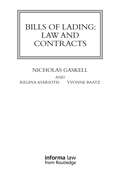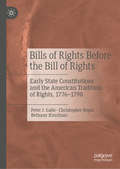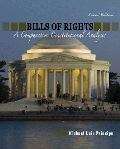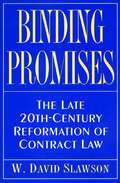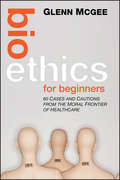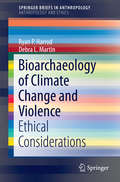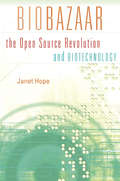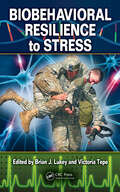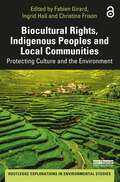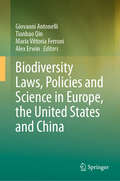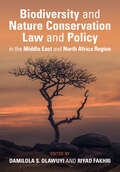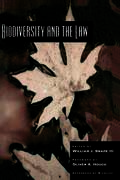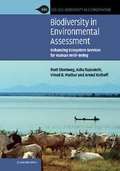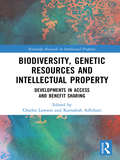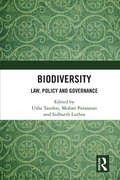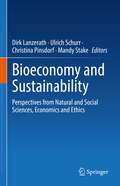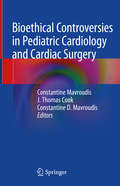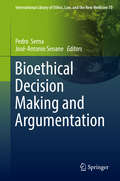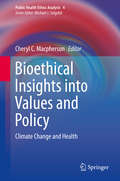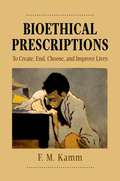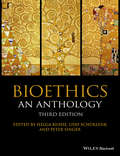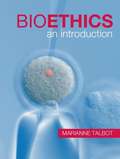- Table View
- List View
Bills of Lading: Law and Contracts (Maritime And Transport Law Library)
by Nicholas GaskellBills of Lading: Law and Contracts provides a detailed legal analysis of common standard form clauses in bills of lading (and waybills) which are in use in the maritime world, as well as a comprehensive examination of the legal principles which are applicable to them. Bills of Lading: Law and Contracts provides a detailed legal analysis of standard form clauses in bills of lading (and waybills) which are in use in the maritime world, as well as a comprehensive examination of the legal principles which are applicable to them.
Bills of Rights Before the Bill of Rights: Early State Constitutions and the American Tradition of Rights, 1776-1790
by Peter J. Galie Christopher Bopst Bethany KirschnerThis book is a documentary history of the rights found in the American state constitutions adopted between 1776 and 1790. Despite the rich tradition of rights at the state level, rights in America have been identified almost exclusively with the national Bill of Rights. Indeed, there is no work that provides a comprehensive treatment of the early state declarations of rights. Rather, these declarations have been viewed as halting first steps towards the adoption of the national Bill of Rights in 1791. Bringing together the full text of the rights provisions from the 13 original states and Vermont, this book presents America’s first tradition of rights on its own terms and as part of this country’s heritage of rights. Early chapters will examine the sources of these rights and provide a comparative framework. An introduction to each chapter will review that state’s colonial history, focusing on any charters or legislation related to rights protections that help explain its constitutional provisions. This work will make it possible for students, scholars, and interested citizens to rediscover the first fruits of the American Revolution.
Bills of Rights: A Comparative Constitutional Analysis (Second Edition)
by Principe Michael Luis PrincipeBills Of Rights: A Comparative Constitutional Analysis new edition incorporates extensive research, and expands into the constitutional and jurisprudential evolution of civil liberties. This second edition has added a new section covering the constitutional history and rights development of four states France, Germany, Italy, and Spain. It gives the reader a better understanding of the issues that are covered by the Constitution and their importance on the evolving world to a global society; the various enacted legislation and their effects on the society and covers an in-depth study on the rights documents.
Binding Promises: The Late 20th-Century Reformation of Contract Law
by W. David SlawsonDuring its classical period, American contract law had three prominent characteristics: nearly unlimited freedom to choose the contents of a contract, a clear separation from the law of tort (the law of civil wrongs), and the power to make contracts without regard to the other party's ability to understand them. Combining incisive historical analysis with a keen sense of judicial politics, W. David Slawson shows how judges brought the classical period to an end about 1960 with a period of reform that continues to this day.American contract law no longer possesses any of the prominent characteristics of its classical period. For instance, courts now refuse to enforce standard contracts according to their terms; they implement the consumer's reasonable expectations instead. Businesses can no longer count on making the contracts they want: laws for certain industries or for businesses generally set many business obligations regardless of what the contracts say. A person who knowingly breaches a contract and then tries to avoid liability is subject to heavy penalties.As Slawson demonstrates, judges accomplished all these reforms, although with some help from scholars. Legislation contributed very little despite its presence in massive amounts and despite the efforts of modern institutions of law reform such as the Conference of Commissioners on Uniform State Laws. Slawson argues persuasively that this comparison demonstrates the superiority of judge-made law to legislation for reforming private law of any kind.
Bio Ethics for Beginners
by Glenn McgeeHow far is too far? 60 cases illustrating modern bioethical dilemmas Bioethics for Beginners maps the giant dilemmas posed by new technologies and medical choices, using 60 cases taken from our headlines, and from the worlds of medicine and science. This eminently readable book takes it one case at a time, shedding light on the social, economic and legal side of 21st century medicine while giving the reader an informed basis on which to answer personal, practical questions. Unlocking the debate behind the headlines, this book combines clear thinking with the very latest in science and medicine, enabling readers to decide for themselves exactly what the scientific future should hold.
Bio-Privacy: Privacy Regulations and the Challenge of Biometrics
by Nancy Yue LiuBio-Privacy: Privacy Regulations and the Challenge of Biometrics provides an in-depth consideration of the legal issues posed by the use of biometric technology. Focusing particularly on the relationship between the use of this technology and the protection of privacy, this book draws on material across a range of jurisdictions in order to explore several key questions. What are the privacy issues in the biometric context? How are these issues currently dealt with under the law? What principles are applied? Is the current regulation satisfactory? Is it applied consistently? And, more generally, what is the most appropriate way to deal with the legal implications of biometrics? Offering an analysis, and recommendations, with a view to securing adequate human rights and personal data protection, Bio-Privacy: Privacy Regulations and the Challenge of Biometrics will be an important reference point for those with interests in the tension between freedom and security.
Bioarchaeological and Forensic Perspectives on Violence
by Debra L. Martin Cheryl P. AndersonEvery year, there are over 1. 6 million violent deaths worldwide, making violence one of the leading public health issues of our time. And with the 20th century just behind us, it's hard to forget that 191 million people lost their lives directly or indirectly through conflict. This collection of engaging case studies on violence and violent deaths reveals how violence is reconstructed from skeletal and contextual information. By sharing the complex methodologies for gleaning scientific data from human remains and the context they are found in, and complementary perspectives for examining violence from both past and contemporary societies, bioarchaeology and forensic anthropology prove to be fundamentally inseparable. This book provides a model for training forensic anthropologists and bioarchaeologists, not just in the fundamentals of excavation and skeletal analysis, but in all subfields of anthropology, to broaden their theoretical and practical approach to dealing with everyday violence.
Bioarchaeology of Climate Change and Violence: Ethical Considerations (SpringerBriefs in Anthropology #6)
by Debra L. Martin Ryan P. HarrodThe goal of this monograph is to emphasize with empirical data the complexity of the relationship between climate change and violence. Bioarchaeology is the integration of human skeletal remains from ancient societies with the cultural and environmental context. Information on mortality, disease, diet and other factors provide important data to examine long chronologies of human existence, particularly during periods of droughts and life-threatening climate changes. Case studies are used to reconstruct the responses and short and long-term adaptations made by groups before, during and after dramatic changes in weather and climate. Interpersonal and group violence is also analyzed. The authors find that while in some cases there is an increase in trauma and violence, in other cases there is not. Human groups are capable of avoiding violent altercations and increasing broad networks of cooperation that help to mitigate the effects of climate change. A case study from the U. S. Southwest is provided that shows the variable and surprising ways that ancient farmers in the past dealt with long term droughts.
Biobazaar: The Open Source Revolution and Biotechnology
by Janet HopeFighting disease, combating hunger, preserving the balance of life on Earth: the future of biotechnological innovation may well be the future of our planet itself. And yet the vexed state of intellectual property law—a proliferation of ever more complex rights governing research and development—is complicating this future. At a similar point in the development of information technology, “open source” software revolutionized the field, simultaneously encouraging innovation and transforming markets. The question that Janet Hope explores in Biobazaar is: can the open source approach do for biotechnology what it has done for information technology? Her book is the first sustained and systematic inquiry into the application of open source principles to the life sciences. The appeal of the open source approach—famously likened to a “bazaar,” in contrast to the more traditional “cathedral” style of technology development—lies in its safeguarding of community access to proprietary tools without discouraging valuable commercial participation. Traversing disciplinary boundaries, Hope presents a careful analysis of intellectual property-related challenges confronting the biotechnology industry and then paints a detailed picture of “open source biotechnology” as a possible solution. With insights drawn from interviews with Nobel Prize–winning scientists and leaders of the free and open source software movement—as well as company executives, international policymakers, licensing experts, and industry analysts—her book suggests that open source biotechnology is both desirable and broadly feasible—and, in many ways, merely awaiting its moment.
Biobehavioral Resilience to Stress
by Victoria Tepe Brian J. LukeyMilitary service involves exposure to multiple sources of chronic, acute, and potentially traumatic stress, especially during deployment and combat. Notoriously variable, the effects of stress can be subtle to severe, immediate or delayed, impairing individual and group readiness, operational performance, and ultimately‘survival. A comprehensive co
Biocultural Rights, Indigenous Peoples and Local Communities: Protecting Culture and the Environment (Routledge Explorations in Environmental Studies)
by Fabien GirardThis volume presents a comprehensive overview of biocultural rights, examining how we can promote the role of indigenous peoples and local communities as environmental stewards and how we can ensure that their ways of life are protected. With Biocultural Community Protocols (BCPs) or Community Protocols (CPs) being increasingly seen as a powerful way of tackling this immense challenge, this book investigates these new instruments and considers the lessons that can be learnt about the situation of indigenous peoples and local communities. It opens with theoretical insights which provide the reader with foundational concepts such as biocultural diversity, biocultural rights and community rule-making. In Part Two, the book moves on to community protocols within the Access Benefit Sharing (ABS) context, while taking a glimpse into the nature and role of community protocols beyond issues of access to genetic resources and traditional knowledge. A thorough review of specific cases drawn from field-based research around the world is presented in this part. Comprehensive chapters also explore the negotiation process and raise stimulating questions about the role of international brokers and organizations and the way they can use BCPs/CPs as disciplinary tools for national and regional planning or to serve powerful institutional interests. Finally, the third part of the book considers whether BCPs/CPs, notably through their emphasis on "stewardship of nature" and "tradition", can be seen as problematic arrangements that constrain indigenous peoples within the Western imagination, without any hope of them reconstructing their identities according to their own visions, or whether they can be seen as political tools and representational strategies used by indigenous peoples in their struggle for greater rights to their land, territories and resources, and for more political space. This volume will be of great interest to students and scholars of environmental law, indigenous peoples, biodiversity conservation and environmental anthropology. It will also be of great use to professionals and policymakers involved in environmental management and the protection of indigenous rights. The Open Access version of this book, available at www.taylorfrancis.com, has been made available under a Creative Commons Attribution-Non Commercial-No Derivatives 4.0 license
Biodiversity Laws, Policies and Science in Europe, the United States and China
by Tianbao Qin Maria Vittoria Ferroni Giovanni Antonelli Alex ErwinThis book offers an in-depth analysis of and multidisciplinary insights into the latest trends in biodiversity laws, policies and science in Europe, the United States, and China. The loss of biodiversity and degradation of ecosystems continues at an alarming rate, harming people, the economy, and the climate. As biodiversity cannot be meaningfully addressed by any single field, a multidisciplinary approach is needed to attain a better understanding of its complexity and to identify prevention and protection systems. Each chapter addresses a specific aspect of biodiversity. Taken together, they provide an innovative exploration of the various facets of biodiversity from the perspectives of law, the social sciences and natural sciences. As such, the book offers an essential theoretical and practical guide for academics, experts, policymakers, and students alike.
Biodiversity and Nature Conservation Law and Policy in the Middle East and North Africa Region
by Damilola S. Olawuyi Riyad FakhriThis book offers a comprehensive and authoritative account of the guiding principles and rules relating to biodiversity, nature conservation, and the protection of cultural heritage in the MENA region. The book introduces readers to the applicable legislation, institutions and rules underpinning the design, approval, financing and implementation of biodiversity and nature-based solutions across the MENA region. It also explores larger questions on legal and institutional frameworks that can help address broader issues of fragmentation, gender inequality, inadequate stakeholder engagement, lack of transparency, limited access to environmental information, and lack of comprehensive domestic legislation, all of which stifle the integrated implementation of biodiversity and nature conservation treaties and the equitable sharing of the benefits derived from biodiversity and nature in the region. Written in a user-friendly style, the book closes with recommendations and reflections on legal and regulatory innovations for advancing biodiversity and nature-based solutions in the MENA region. This title is also available as open access on Cambridge Core.
Biodiversity and the Law
by Mollie Beattie Scott Hajost John Pendergrass Jason Patlis Leesteffy Jenkins Dinah BearBiodiversity and the Law is a timely and provocative volume that combines historical perspective and cutting-edge legal analysis in an authoritative and broad discussion of biodiversity and the law. Leading legal and policy experts consider a variety of options for the worldwide protection of biodiversity and present a succinct but comprehensive overview of the legal mechanisms available. They examine how conservation advocates can better utilize existing law, and consider what new law is needed.Among the topics considered are: scientific and policy foundations of biodiveristy protection domestic efforts to establish an effective endangered species protection regime international biodiversity protection biodiversity as a genuinely public entity the future of biodiversity law Contributors include Mollie Beattie, Don Waller, Jason Patlis, Lindell Marsh, Todd Olson, Peter Jenkins, Suzanne Iudicello, John Pendergrass, Dinah Bear, Walter Kuhlmann, Rodger Schlickeisen, David Downes, and others.
Biodiversity in Environmental Assessment
by Roel Slootweg Asha Rajvanshi Vinod B. Mathur Arend KolhoffHuman induced development activities are introduced with insufficient attention to their consequences for our living environment, even in cases where environmental assessments have been carried out. This apparent lack of attention to biodiversity in environmental assessment is rooted in the difficulties we have in adequately addressing biodiversity within the scope, time frame and budget allocated for assessments. This book provides a conceptual background and practical approaches to overcome these difficulties. It integrates the objectives of the Convention on Biological Diversity, its ecosystem approach, and the conceptual framework of the Millennium Ecosystem Assessment into a comprehensive approach to biodiversity in environmental assessment. It highlights the need to consider the value of biodiversity based on its use by each stakeholder, addresses the importance of both social and economic development to reach the Millennium Development Goals, and provides insights into ways to balance present and future needs.
Biodiversity, Genetic Resources and Intellectual Property: Developments in Access and Benefit Sharing (Routledge Research in Intellectual Property)
by Charles Lawson Kamalesh AdhikariDebates about Access and Benefit Sharing (ABS) have moved on in recent years. An initial focus on the legal obligations established by international agreements like the United Nations Convention on Biological Diversity and the form of obligations for collecting physical biological materials have now moved to a far more complex series of disputes and challenges about the ways ABS should be implemented and enforced: repatriation of resources, technology transfer, traditional knowledge and cultural expressions; open access to information and knowledge, naming conventions, farmers’ rights, new schemes for accessing pandemic viruses and sharing DNA sequences, and so on. Unfortunately, most of this debate is now crystallised into apparently intractable discussions such as implementing the certificates of origin, recognising traditional knowledge and traditional cultural expression as a form of intellectual property, and sovereignty for Indigenous peoples. Not everything in this new marketplace of ABS has been created de novo. Like most new entrants, ABS has disrupted existing legal and governance arrangements. This collection of chapters examines what is new, what has been changed, and what might be changed in response to the growing acceptance and prevalence of ABS of genetic resources. Biodiversity, Genetic Resources and Intellectual Property: Developments in Access and Benefit Sharing of Genetic Resources addresses current issues arising from recent developments in the enduring and topical debates about managing genetic resources through the ABS regime. The book explores key historical, doctrinal, and theoretical issues in the field, at the same time developing new ideas and perspectives around ABS. It shows the latest state of knowledge and will be of interest to researchers, academics, policymakers, and students in the fields of intellectual property, governance, biodiversity and conservation, sustainable development, and agriculture.
Biodiversity: Law, Policy and Governance
by Usha Tandon Mohan Parasaran Sidharth LuthraConservation of biodiversity is a fundamental concern towards securing a sustainable future. This volume argues that despite various domestic and international policies and legal frameworks on biodiversity conservation — be it forest, wildlife, marine, coastal, etc. — their implementation suffers from many deficiencies. It explores the factors that hinder effective implementation of these policies and frameworks. It also analyses existing laws, both international and domestic, to identify inherent problems in the existing legal system. The book maintains that careful adherence to established procedures and protocols, public awareness, filling the lacuna in legal framework, and a strong political will are sine qua non for effective conservation of biodiversity and sustainable development. The volume defends the protection of traditional knowledge and participation of indigenous communities along with reinforcements of intellectual property in this regard. It also commends the role played by the Indian judiciary, especially the Supreme Court of India and India’s National Green Tribunal for the preservation and enhancement of natural resources by applying established as also evolving principles of environmental law. This book will be useful to scholars and researchers of environmental studies, development studies, policy studies and law related to biodiversity and conservation.
Bioeconomy and Sustainability: Perspectives from Natural and Social Sciences, Economics and Ethics
by Ulrich Schurr Dirk Lanzerath Christina Pinsdorf Mandy StakeIn this edited volume, scientists from different disciplines discuss modern biotechnological processes and a knowledge-based bioeconomy. The authors base their arguments on ecological, economic, legal, social and ethical aspects. Moreover, they explore the opportunities, risks, and challenges of bioeconomic concepts and biotechnologies in many subject areas. The chapters consider land use, nature and environment, nutrition, technology and governance, energy, economy, law and regulation, as well as ethics. A special focus should be on new technologies and how they can be used, without compromising the ambitious goal of creating a more sustainable, but also fair world. To do justice to this broad array of topics, the editors frame all topics in overarching introductions and close the volume with final conclusions. Thereby this volume offers data and critical thoughts for any member of a Bioeconomy – be it from academia, the industry or public regulation.
Bioequity – Property and the Human Body (Medical Law And Ethics Ser.)
by Nils HoppeRecent scandals involving the use of human body parts have highlighted the need for legal clarification surrounding property law and the use of human tissue. This book advances the notion that the legal basis for dealing with this is already available in the law but has thus far neither been used nor discussed. Proposing an alternative approach to constructing entitlements in human tissue and resolving resulting property conflicts, a new methodology is also advanced for abstracting different concepts within the debate which enables comparison and distinction between different cases of entitlement and retention.
Bioethical Controversies in Pediatric Cardiology and Cardiac Surgery
by Constantine Mavroudis J. Thomas Cook Constantine D. MavroudisThis title reviews the bioethical issues in congenital heart disease and other difficult pediatric cardiology and cardiac surgical situations. It provides considered opinions and recommendations as to the preferred actions to take in these cases, stressing the importance of making informed decisions that are bioethically sound and doing so using considered reasoning of all the related sensitive issues.Bioethical Controversies in Pediatric Cardiology and Cardiac Surgery provides detailed recommendations on potential solutions to make bioethical decisions in difficult clinical scenarios. There is particular emphasis on controversies involving surgery for hypoplastic left heart syndrome, futility, informed consent, autonomy, genomics, and beneficence. It is intended for use by a wide range of practitioners, including congenital heart surgeons, pediatric cardiologists, pediatric intensivists, nurse practitioners, physician’s assistants, and clinical ethicists.
Bioethical Decision Making and Argumentation (International Library of Ethics, Law, and the New Medicine #70)
by Pedro Serna José-Antonio SeoaneThis book clarifies the meaning of the most important and pervasive concepts and tools in bioethical argumentation (principles, values, dignity, rights, duties, deliberation, prudence) and assesses the methodological suitability of the main methods for clinical decision-making and argumentation. The first part of the book is devoted to the most developed or promising approaches regarding bioethical argumentation, namely those based on principles, values and human rights. The authors then continue to deal with the contributions and shortcomings of these approaches and suggest further developments by means of substantive and procedural elements and concepts from practical philosophy, normative systems theory, theory of action, human rights and legal argumentation. Furthermore, new models of biomedical and health care decision-making, which overcome the aforementioned criticism and stress the relevance of the argumentative responsibility, are included.
Bioethical Insights into Values and Policy: Climate Change and Health (Public Health Ethics Analysis #4)
by Cheryl C. MacphersonChanges in earth's atmosphere, oceans, soil, weather patterns, and ecosystems are well documented by countless scientific disciplines. These manifestations of climate change harm public health. Given their goals and social responsibilities, influential health organizations recognize health impacts compounded by geography, social values, social determinants of health, health behaviors, and relationships between humans and environments primarily described in feminist ethics and environmental ethics. Health impacts are relevant to, but seldom addressed in bioethics, global health, public policy, or health or environmental policy. This book is the first to describe cultural, geographic, and socioeconomic factors that influence the regional significance of these impacts and frame them for bioethics and policy analyses.
Bioethical Prescriptions: To Create, End, Choose, and Improve Lives
by F. M. KammBioethical Prescriptions collects F. M. Kamm's articles on bioethics, which have appeared over the last twenty-five years and which have made her among the most influential philosophers in this area. Kamm is known for her intricate, sophisticated, and painstaking philosophical analyses of moralproblems generally and of bioethical issues in particular. This volume showcases these articles - revised to eliminate redundancies - as parts of a coherent whole. A substantive introduction identifies important themes than run through the articles. Section headings include Death and Dying; Early Life (on conception and use of embryos, abortion, andchildhood); Genetics and Other Enhancements (on cloning and other genetic technologies); Allocating Scarce Resources; and Methodology (on the relation of moral theory and practical ethics).
Bioethics
by Peter Singer Udo Schüklenk Helga KuhseNow fully revised and updated, Bioethics: An Anthology, 3rd edition, contains a wealth of new material reflecting the latest developments. This definitive text brings together writings on an unparalleled range of key ethical issues, compellingly presented by internationally renowned scholars. The latest edition of this definitive one-volume collection, now updated to reflect the latest developments in the field Includes several new additions, including important historical readings and new contemporary material published since the release of the last edition in 2006 Thematically organized around an unparalleled range of issues, including discussion of the moral status of embryos and fetuses, new genetics, neuroethics, life and death, resource allocation, organ donations, public health, AIDS, human and animal experimentation, genetic screening, and issues facing nurses Subjects are clearly and captivatingly discussed by globally distinguished bioethicists A detailed index allows the reader to find terms and topics not listed in the titles of the essays themselves
Bioethics
by Marianne TalbotProviding readers with the confidence needed to debate key issues in bioethics, this introductory text clearly explains bioethical theories and their philosophical foundations. Over 250 activities introduce topics for personal reflection, and discussion points encourage students to think for themselves and build their own arguments. Highlighting the potential pitfalls for those new to bioethics, each chapter features boxes providing factual information and outlining the philosophical background, along with detailed case studies that offer an insight into real-life examples of bioethical problems. Within-chapter essay questions and quizzes, along with end-of-chapter review questions, allow students to check their understanding and to broaden their thinking about the topics discussed. The accompanying podcasts by the author (two of whose podcasts on iTunesU™ have attracted over 3 million downloads) explain points that might be difficult for beginners. These, along with a range of extra resources for students and instructors, are available at www. cambridge. org/bioethics.
